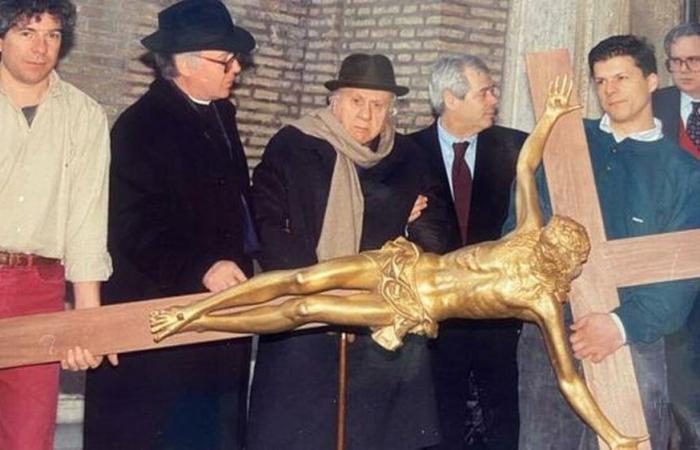Before his death, the great sculptor Francesco Messina decided to donate dozens and dozens of works, sketches, statues and plaster models to the Vatican so that they could be displayed in suitable spaces. «You take care of and protect works of art like no one else in the world», the master who passed away in 1995 always said to his great friend, Monsignor Americo Ciani, secretary of the Apostolic Library at the time. A strong intellectual and spiritual relationship united them and it was precisely this bond of trust that convinced the artist and his daughter Paola to inspire the transfer of ownership of the works.
«The statues and sketches were transported from the Milan studio to the Vatican. We identified a freight forwarder and the unloading of the packaged works took place in front of the Fabbrica di San Pietro where they were destined. Unfortunately I couldn’t check further since I didn’t work in those offices but in the Library, and consequently it didn’t fall within my competence. In short, I didn’t bother with it and nothing more was heard of it from then on. Every now and then when I went to visit Cardinal Virgilio Noè I saw that in his study he had some works from Messina”, says Ciani.
THE WILLS
In 1995 when he died, Messina recommended to his priest friend that his wishes linked to the legacy be respected. The desire was to set up a permanent exhibition in the spaces of the Dome with all the donated plaster sketches, statues and other works. It’s a shame that from then to today, much of that heritage has been lost. Ciani, who is 88 years old and sees time slipping away from him, is concerned not to betray the will of his generous friend. «I wonder what happened to all the works? Where are? Are they still in the Vatican? A question that he has asked various offices over the years but always received hasty or dismissal answers.
Ciani, who is currently one of the canons emeritus of St. Peter’s, has preserved the correspondence he had with the sculptor of the great Dying Horse created for Rai in 1965. «In 1991 the artist agreed to have a large exhibition set up in the Charlemagne Wing and it was the opportunity to lend some of his most famous sculptures. He thus had the opportunity to see with his own eyes the care with which the art treasures in the Vatican Museums were preserved”, recalls Ciani.
The friend Monsignor took care to inform the leaders of the Holy See about Messina’s wishes by following the stages of the stipulation handled by a Milanese law firm trusted by the maestro. Since the works were mainly intended for the Fabbrica di San Pietro, the person who signed the transfer of ownership was Cardinal Archpriest Noè, now deceased. Other works, however, went to the Vatican Museums, where they are exhibited today: such as the Job, a magnetic bronze of which the artist was particularly fond. «It portrays an old man who often passed by his house. Messina made him pose for hours and hours with his knee on the stone. One day he told him that he couldn’t take it anymore and he replied that it was exactly what he wanted, to bring out the great patience of the biblical Job”, says Don Americo. «He also donated the copy he had of Michelangelo’s Pietà Rondanini, which is also visible in the Museums. He bought it in Florence in the 1930s. For him he was a presence, a companion while working in the Milanese studio. The relationship with Michelangelo’s masterpiece was so profound that Messina included it at the end of his autobiography “Poveri Giorni”, in 1974». Also on display today to the public are The Horrors of War, a series of bas-reliefs in pure gold, the large crucifix that is in the Mater Ecclesial Monastery and the one that is in the chapel of Santa Marta and the statue of Santa Elisabetta in the Library. «With a letter in 1994, John Paul II wanted to thank him for the silver sculptures and other works destined for the Library and those which enrich the museum collections. He was referring to three silver statues: a Saint Philip Neri and two altar boys for a total of 15 kilograms of silver. I brought them personally. I saw these last two statues again in the apostolic palace. Saint Philip Neri, however, I have never seen again, I imagine that he is still there, let’s hope”, adds the priest.
THE WORKS
Among statues and sketches, in the paper list of the transport slip and the notarial one, there are at least thirty works. What happened to them remains a mystery. Once Poggi and Noè died, they were never spoken of again. «”And above all, no permanent exhibition was created in the Octagon of the basilica or in the Fabbrica (where, moreover, there is a museum). After Cardinal Noè came Cardinal Angelo Comastri. When I went to his studio to visit him I saw that he had the Assumption of Mary. Someone told me that after Noah’s death many works were transported to Pavia, but I don’t know how to ascertain this information, in fact Messina would have wanted (because he specifically asked me) for them all to be exhibited to be enjoyed by people, especially the plaster casts. . We hope they are still in the Vatican, perhaps in some basement.” Monsignor Ciani looks at the bronze crucifix that Messina gave him before he died. “Above all, I hope that those who know will speak.”
© ALL RIGHTS RESERVED
Read the full article at
The messenger






